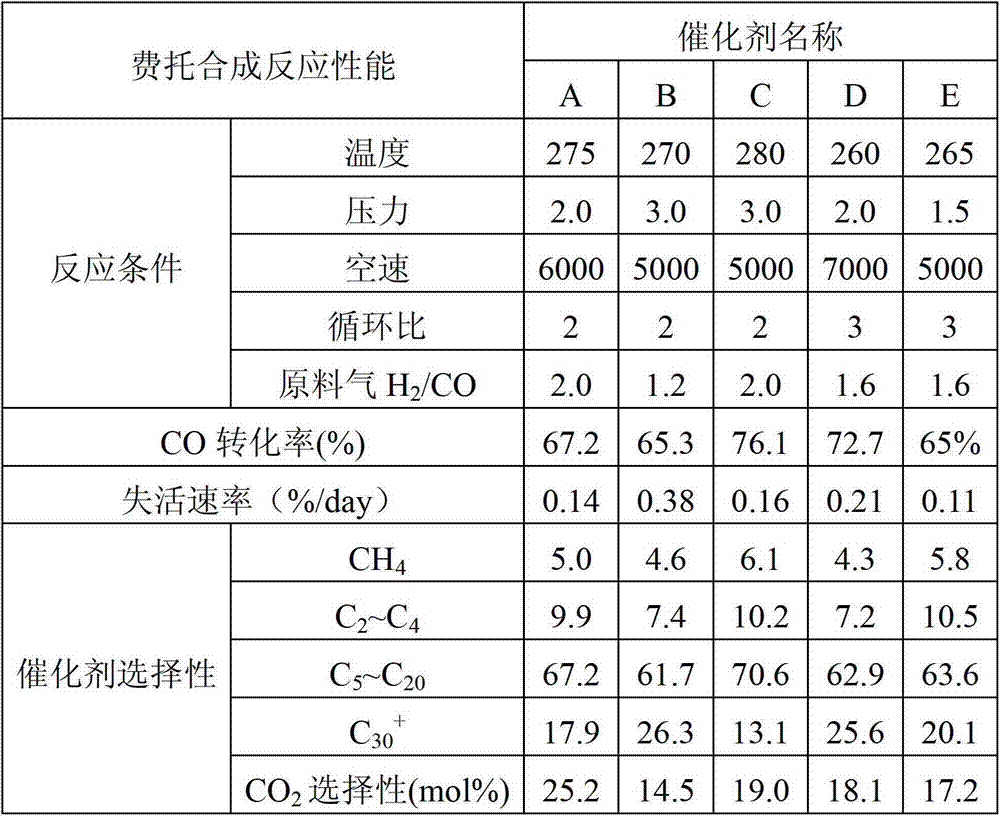Reduction method for iron-based catalyst for Fischer-Tropsch synthesis in fixed bed
An iron-based catalyst and Fischer-Tropsch synthesis technology, applied in chemical instruments and methods, catalyst activation/preparation, physical/chemical process catalysts, etc., can solve problems such as inability to continue the reaction, affect catalyst activity, and excessive carbon deposition in the catalyst. Achieve the effect of strong anti-wear ability, less carbon deposition on the catalyst, and less carburization of the catalyst
- Summary
- Abstract
- Description
- Claims
- Application Information
AI Technical Summary
Problems solved by technology
Method used
Image
Examples
Embodiment 1
[0031] Load 5g of Fischer-Tropsch synthesis iron-based catalyst into the fixed bed reactor, the catalyst composition is 100Fe / 10Ce / 5Cu / 6K / 30SiO 2 (for mass ratio). Feed H into the fixed bed reactor 2 , adjust the reactor pressure to 2.0MPa, and the space velocity to 3000h -1 , the circulation ratio is 5, and the reactor is raised to 360° C. by room temperature with a temperature increase rate of 10° C. / h for 6 hours. Reduce the reduction temperature to 320°C at 10°C / h, switch the reducing atmosphere to H 2 / C 2 h 4 (20:1 molar ratio) mixed gas, space velocity 3000h -1 , the circulation ratio is 5, and the iron-based catalyst after reduction is obtained at 320° C. for 20 h under the atmosphere, which is denoted as A.
[0032] After the reduction, the reactor is adjusted to the reaction conditions to carry out the Fischer-Tropsch synthesis reaction. The reaction conditions are: the temperature is 275°C, the pressure is 2.0MPa, and the raw material gas is H 2 / CO=2.0 (mol...
Embodiment 2
[0035]Load 10g Fischer-Tropsch synthesis iron-based catalyst into the fixed bed reactor, the catalyst composition is 100Fe / 5La / 3Cu / 1Rb / 30Al 2 o 3 (for mass ratio). Feed H into the fixed bed reactor 2 , adjust the reactor pressure to 3.0MPa, and the space velocity to 500h -1 , the circulation ratio is 15, and the reactor is raised to 260° C. by room temperature with a temperature increase rate of 5° C. / h for 24 hours at a constant temperature. Switch the reducing atmosphere to H 2 / C 3 h 8 (Molar ratio is 10:1) mixed gas, space velocity 500h -1 , the circulation ratio is 10, and the temperature is kept at 260° C. for 48 h to obtain the reduced iron-based catalyst, denoted as B.
[0036] After the reduction, the reactor is adjusted to the reaction conditions to carry out the Fischer-Tropsch synthesis reaction. The reaction conditions are: temperature 270°C, pressure 3.0MPa, raw material gas is H 2 / CO=1.2 (molar ratio), the space velocity is 5000h -1 , and the cycle ra...
Embodiment 3
[0038] Load 10g Fischer-Tropsch synthesis iron-based catalyst into the fixed bed reactor, the catalyst composition is 100Fe / 3Cr / 1K / 15SiO 2 (for mass ratio). H in the fixed bed reactor 2 / C 3 h 8 =1 mixed gas, adjust the reactor pressure to 0.3MPa, and the space velocity to 1000h -1 , the circulation ratio is 0 (the tail gas does not circulate), the reactor is raised from room temperature to 280°C at a rate of 10°C / h, and then the temperature is kept constant for 30h. The reduced iron-based catalyst was obtained, denoted as C.
[0039] After the reduction, the reactor is adjusted to the reaction conditions to carry out the Fischer-Tropsch synthesis reaction. The reaction conditions are: the temperature is 280°C, the pressure is 3.0MPa, and the raw material gas is H 2 / CO=2.0 (molar ratio), the space velocity is 5000h -1 , and the cycle ratio is 2.0.
PUM
 Login to View More
Login to View More Abstract
Description
Claims
Application Information
 Login to View More
Login to View More - R&D
- Intellectual Property
- Life Sciences
- Materials
- Tech Scout
- Unparalleled Data Quality
- Higher Quality Content
- 60% Fewer Hallucinations
Browse by: Latest US Patents, China's latest patents, Technical Efficacy Thesaurus, Application Domain, Technology Topic, Popular Technical Reports.
© 2025 PatSnap. All rights reserved.Legal|Privacy policy|Modern Slavery Act Transparency Statement|Sitemap|About US| Contact US: help@patsnap.com

